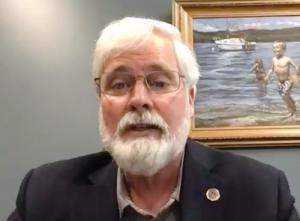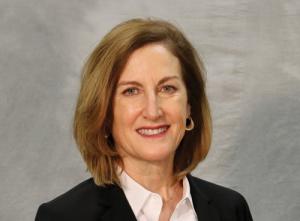Connecting the Dots
Paul Kjellander is the president of NARUC, Judith Jagdmann is First Vice President and Michael Caron is Second Vice President.
As we write this article, phrases like unprecedented times and new normal have become cliché, the financial impact on the utilities we regulate and the customers they serve is unknown, and the end to this global health crisis is anyone's guess.

The COVID-19 dilemma has not stopped time and it is very clear that the problems facing utility regulators did not hit the pause button either. While uncertainty clearly rules the day, one thing we can be proud of is that our association, NARUC, chose to stay relevant during this pandemic, a decision that will ultimately pay dividends to our members.
It would have been easy to simply put everything on hold and wait for this health scare to pass. Instead, NARUC's leadership team repelled the temptation to cancel its major conferences and moved forward with a renewed sense of urgency to explore opportunities to better serve our members.
This led us down a path to focus on, further develop, and fully deploy NARUC's core competencies as we continue building the association's brand. At the base of this effort is the development of a broad multiyear theme that is more inclusive of all the utility sectors we regulate.
Every state regulator knows the utilities in their jurisdictions are facing extraordinary pressure created by policy shifts, growing consumer expectations, and rapidly evolving technological advancements that could completely alter the value proposition of the services they provide.
 Paul Kjellander: A multiyear theme, Connecting the Dots: Innovative/Disruptive Technology and Regulation, explores emerging technologies and innovations that will impact utilities.
Paul Kjellander: A multiyear theme, Connecting the Dots: Innovative/Disruptive Technology and Regulation, explores emerging technologies and innovations that will impact utilities.
Pressing issues about deep decarbonization, electrification, grid modernization, aging infrastructure, the need for more renewable energy resources, cybersecurity, and the surge of distributed energy resource development, along with the need for more contaminate wastewater tracking are among the many drivers that will alter the utility landscape.
The looming concerns are which emerging technologies and innovations will carry us forward and what impact will those changes have on the current regulatory regime. As utilities confront these changes, questions will arise.
What role should regulators play in the integration of these potentially disruptive technologies and innovations? How do we connect the dots that will help all stakeholders benefit from the changing utility ecosystem?
This is what led us to pursue a multiyear theme titled: "Connecting the Dots: Innovative/Disruptive Technology and Regulation." This theme seeks to explore the many emerging technologies and innovations that will impact electricity, natural gas, telecommunications, and water/wastewater utilities.
 Judith Jagdmann: An opportunity to explore alternative and optional forms of regulation that might incent implementation of new technology and practices can emerge from this topic.
Judith Jagdmann: An opportunity to explore alternative and optional forms of regulation that might incent implementation of new technology and practices can emerge from this topic.
Beyond a clearer picture of the emerging technologies and their potential roles in the utility ecosystem, this theme will include conversations on the role of regulation in this process. It will also include a discussion of when regulators should be innovators, when they should get out of the way, and when they should just say no. An opportunity to explore alternative and optional forms of regulation that might incent the implementation of new technology and practices can also emerge from this topic.
The dots that need to be connected will help us understand the various ways that technological advances emerge, such as private entrepreneurial innovation, government grant programs, public/private partnerships, and policy driven initiatives.
Included in this discussion are the elements that either derail or advance these technologies into the marketplace. Through this conversation we can learn from the national labs and other innovators about what is on the horizon and what impacts these emerging technologies might have on society and the regulatory process. We can also explore what problems might emerge as these technologies are integrated into existing systems.
Technological areas of interest will include such things as renewable natural gas (RNG), transitional technologies for smart grid and DER deployment and integration, AMI for water systems, electrification and its impacts on reliability and resilience, hydrogen, advanced and small scale nuclear, clean coal, carbon-capture utilization and storage, cloud-based technologies, batteries and other storage options, and hybrid energy systems.
 Michael Caron: As we emerge from this pandemic and look to the future, this multiyear theme will provide us with opportunities we have only begun to imagine.
Michael Caron: As we emerge from this pandemic and look to the future, this multiyear theme will provide us with opportunities we have only begun to imagine.
Ultimately, we believe this multiyear theme will provide a host of value propositions that include but are not limited to the following:
It allows us to develop an informed response to a constantly changing utility sector environment.
It provides a platform that allows NARUC to be honest brokers in the ongoing discussions.
It provides a more visible forum to promote the work already underway at NARUC through the Center for Partnerships and Innovation and the National Regulatory Research Institute.
It creates opportunities to update and enhance our curriculum material for rate school and for new commissioner orientations.
It creates a clearer and consistent platform to assist with the pursuit of future funding sources.
It offers a nexus to our international efforts recognizing that innovation and technology in the utility sector is global in nature.
It provides a basis for resolutions from this effort to give NARUC a broader advocacy position to work from.
Over the next few years, we will explore topics associated with innovation in greater detail in our committee meetings and in general conference sessions. Toward this effort we can draw on sources like Maryland Public Service Commissioner Jason Stanek who has helped launch a pilot project that allows utilities to own and operate EV charging stations, Washington Utilities and Transportation Commissioner Ann Rendahl and her colleagues who are developing guidelines for multi-year rate plans and performance-based ratemaking, Arkansas Public Service Commissioner Kim O'Guinn, who continues to fine tune the implementation of formula rate reviews, and Hawaii Public Utilities Commissioner Jay Griffin who is examining rate designs and grid infrastructure to enable distributed energy resources and energy storage.
As we emerge from this pandemic and look to the future, this multiyear theme will provide us with opportunities we have only begun to imagine.
Perhaps through exposure of our theme in the Public Utilities Fortnightly special issue on innovation, this publication's readers might take an interest in helping NARUC pursue this conversation far into the future.



